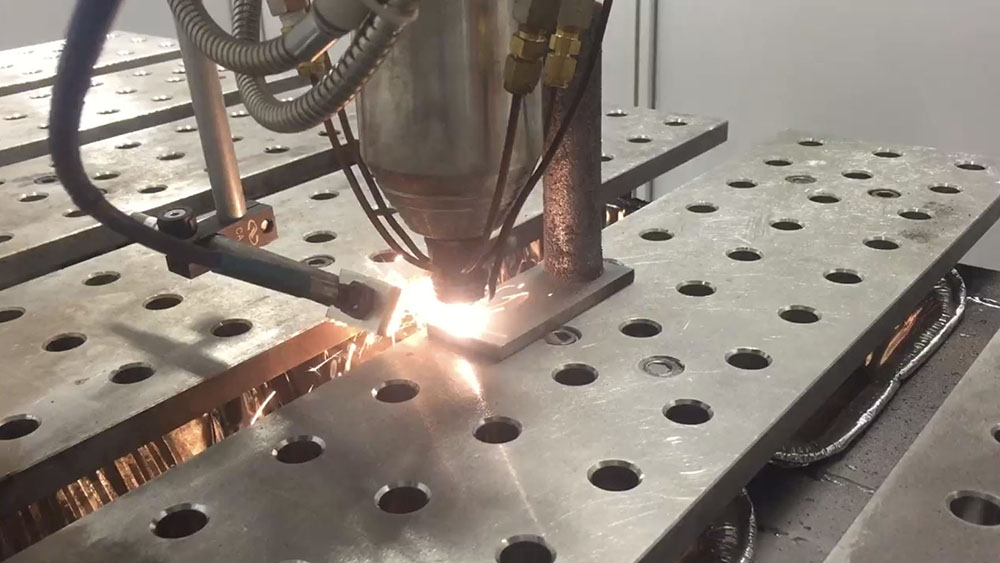
Additive manufacturing techniques have great potential to improve productivity and energy efficiency during part fabrication. The “bottom up” approach, creating parts layer by layer, “cuts out many steps of the traditional manufacturing process and makes it an appealing method,” said Jyotirmoy Mazumder, Robert H. Lurie Professor of Mechanical Engineering. “But the technologies used today all fall short in the same area: inline quality control.”
Even small defects in fabricated parts can have a large impact on performance and safety, that’s why automotive and other manufacturers need to be on the lookout for several types of defects, including inaccuracies in part dimensions and composition, microscale cracks, porosity—small voids that can form when welding galvanized steel and weaken the weld—and others.
A number of methods exist for postmortem part analysis and inspection, but they are time- and labor-intensive, and some lack the desired degree of accuracy. They also forego a key opportunity offered by additive manufacturing: the chance to make layer-by-layer corrections while part fabrication is underway rather than after the fact.
“The current methods we have just don’t give us enough information fast enough,” said Mazumder, who directs the U-M Center for Laser-Aided Intelligent Manufacturing and the National Science Foundation Industry-University Cooperative Research Center for Lasers and Plasmas for Advanced Manufacturing.
Building on decades of research in materials processing and laser-aided manufacturing, Mazumder has developed and demonstrated a holistic, closed-loop system for inline quality control of laser sintering and direct metal deposition manufacturing processes.
Mazumder’s in-situ optical diagnostics system, dubbed the Smart Optical Manufacturing System (SOMS), is helping establish a new paradigm, “certify as you build,” as he explains in an article published in 2015 in the journal Procedia CIRP.
The SOM system includes a number of optical sensors to detect defects and diagnose composition inconsistencies and other problems, including phase transformation. A fast-response optical sensor, based on optical emission spectroscopy, uses the plasma created by laser-aided additive manufacturing to detect pinholes, porosity and tiny cracks within milliseconds.
“The plasma created by the manufacturing process acts, in a sense, as a mirror that reflects what’s happening at the interface between the laser and the material as well as within the material,” Mazumder said. “Extracting and analyzing information with machine learning algorithms can lead us to the defects and help us make corrections.”
Analyzing the laser-induced plasma also provides valuable information about material composition. Similarly, using algorithms to analyze the relationship between spectral lines from different materials alerts inspectors to possible phase changes taking place as the metals are heated to high temperatures. Experimentally, Mazumder has successfully predicted the composition as well as phase transformation in a nickel-aluminum system.
The SOMS also includes sensors to monitor temperature in order to determine, and control, the cooling rate of materials. “We can retrieve all kinds of information from the light very quickly,” he said, “and we don’t even have to be in the same facility—we can observe from a distance.”
Mazumder’s “certify as you build” approach incorporates technologies in a seamless way that yields capabilities greater than the sum of the individual parts. This includes identification of problems in less than a second, rather than the hours or days of conventional approaches. Identifying defects quickly enables manufacturers to course correct and prevent defects from worsening.
“We’re taking ideas from basic physics and applying them to manufacturing— it’s an ‘atom-to-application’ approach,” Mazumder said. Using data from quantum mechanics and predicting properties in continuum mechanics “poses some interesting physics questions. We know it works experimentally, and now we’re proving the theory.”
Mazumder is also working to extend the system to determine material strength from the laser-induced plasma.
“It’s a highly flexible system that opens new doors for manufacturers, including improved remote manufacturing and improved performance and quality of multi-material manufacturing,” Mazumder said. “It can lower costs and reduce energy consumption—all good things that can help OEMs in a range of industries.”
Funding for the work has come from the National Science Foundation, the National Institute of Standards and Technology and from industry sponsors.